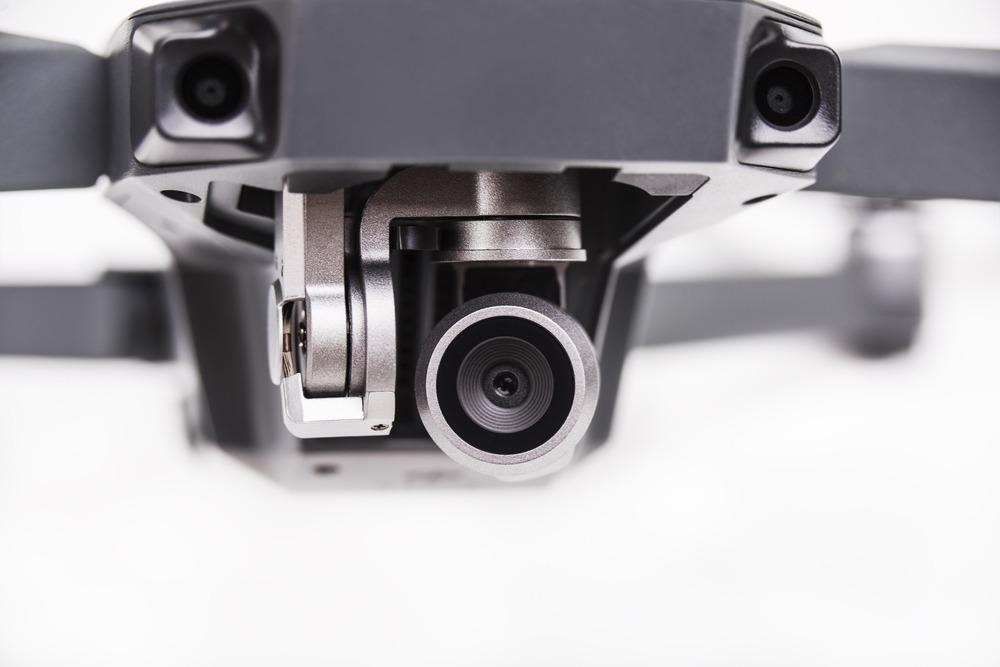
Image Credit: Victoria Shapiro/Shutterstock.com
Attaching cameras onto drones allows us to get a vantage point that cannot be seen from the ground. Previous ways of maintaining an aerial view for mapping and surveys involved chartering an airplane or helicopter with an on-board camera crew. This method's output shots were usually of a very low quality due to onboard vibrations and hand movements. The addition of a stabilization gimbal to the setup allowed for more stable shots from an aircraft, but high chartering costs were still a problem. This article looks at the recent technology used in drones and how it benefits different applications.
A History of Cameras in Drones
The first uses of an unmanned aerial vehicle can be observed in the Venice attack by Austria, which saw the use of balloons to deploy explosives. The 1860s saw the use of early cameras to take aerial photographs of the ground. The earliest cases of cameras being used on drones can be traced back to their use in the Vietnam war for aerial surveillance and reconnaissance. These cameras were typically used to record enemy movement and to map out enemy territory safely.
The Technological Advancement of Unmanned Aerial Vehicle Cameras
Unmanned aerial vehicles have come a long way since balloons. The 1960s saw the introduction of advanced UAVs such as the Ryan147Bs lightning bug. The discovery of stereoscopy by Fredrick Charles Victor Laws's initial aerial photography experiments with the manned No.1 squadron RAF fighter aided our understanding of cartography and aerial image analysis. The Anschütz strut-folding camera was typically used in early reconnaissance aircraft.
Aerial photography has come a long way with recent drones capable of shooting stable 4k cinematic videos due to their onboard stabilization.
The introduction of the Go-pro camera also opened new doors for outdoor motion photography. Their rigid design allows them to withstand the impact with little to no damage. Because of this, they are usually used in a scenario with a lot of movement, making them ideal for attachment onto smaller-sized drones.
Drones that use Go-pro technology are The Hubsan H109S Pro and the GoPro Karman. These are capable of taking aerial footage at 1080p at 30 frames per second. This puts them in the relatively lower end of aerial photography.
The Hubsan H109S Pro does not have a gimbal for camera stabilization, leading to shaky footages. This also makes them incompatible for cinematic shooting.
The most notable drones in the aerial photography and videography space can be seen in the DJI fleet of drones. The release of the DJI phantom 2 saw widespread adoption amongst creatives. Phantom 2 reduced the skill level required to take great aerial footage. The addition of GPS positioning also allows the drone to be flown more accurately. It featured a new gimbal camera mount which vastly improved image stabilization and leveling performance.
More advanced DJI drones such as the Phantom 4 is capable of shooting at 4k and taking 12 MP quality pictures with the addition of more advanced tracking capability.
Significant advancements in UAV cameras can be observed in the DJI mini 2 drones. Weighing a small 249 grams, the DJI mini is still able to shoot 4k at 30 fps. The small weight class means the drone can be exempt from regulation in certain countries, lowering the entry barrier for conveniently shooting high-quality footage.
Another type of UAV camera currently becoming more widespread in the industry is first-person view cameras on drones. FPV cameras are commonplace in drone racing as pilots can get a head-on display of what the drone sees on a monitor or FPV google.
Pilots control the drone using a video feed from the FPV camera. This allows for a level of control and maneuverability not previously seen in typical methods.
FPV cameras are typically compact and lightweight, making them ideal for the placement of UAVs. FPV cameras use two main types of image sensors, namely CMOS and CCD.
The main difference between these two image sensors is how the image is captured. CMOS captures images pixel by pixel using a rolling shutter as opposed to the CCD, which captures an entire image at once using a global shutter.
The resolution of the FPV field is measured in TV lines due to it being an analog video feed. The main limitation to the use of FPV cameras on unmanned aerial vehicles is the latency issue. Low latency causes a significant delay between the transmission and reception of the video feed. This could lead to problems when flying at high speeds, as the drone position could change before the feed is received on the FPV goggles. This can be avoided by having a dedicated system for the first-person video feed.
Future improvements implement computer vision and machine learning to perform high-level tasks such as facial detection from a drone.
References and Further Reading
Corrigan, F., 2021. What Is FPV Camera Technology In Drones And Best Uses. [online] DroneZon. Available at: https://www.dronezon.com/learn-about-drones-quadcopters/what-is-fpv-camera-fov-tvl-cmos-ccd-technology-in-drones/ [Accessed 24 March 2021].
Feist, J. and 2, D., 2021. DJI Mavic Air 2. [online] Drone Rush. Available at: https://dronerush.com/product/dji-mavic-air-2/ [Accessed 24 March 2021].
Drone Rush. 2021. DJI Phantom drones guide: iconic design. [online] Available at: https://dronerush.com/dji-phantom-drones-comparison-guide-3335/ [Accessed 24 March 2021].
Vyas, K., McFadden, C., Ozdemir, D. and McFadden, C., 2021. A Brief History of Drones: The Remote Controlled Unmanned Aerial Vehicles (UAVs). [online] Interestingengineering.com. Available at: https://interestingengineering.com/a-brief-history-of-drones-the-remote-controlled-unmanned-aerial-vehicles-uavs [Accessed 24 March 2021].
digitalcameraworld. 2021. The 10 best camera drones in 2021: these are the best drones for photography. [online] Available at: https://www.digitalcameraworld.com/uk/buying-guides/the-10-best-camera-drones [Accessed 24 March 2021].
Disclaimer: The views expressed here are those of the author expressed in their private capacity and do not necessarily represent the views of AZoM.com Limited T/A AZoNetwork the owner and operator of this website. This disclaimer forms part of the Terms and conditions of use of this website.